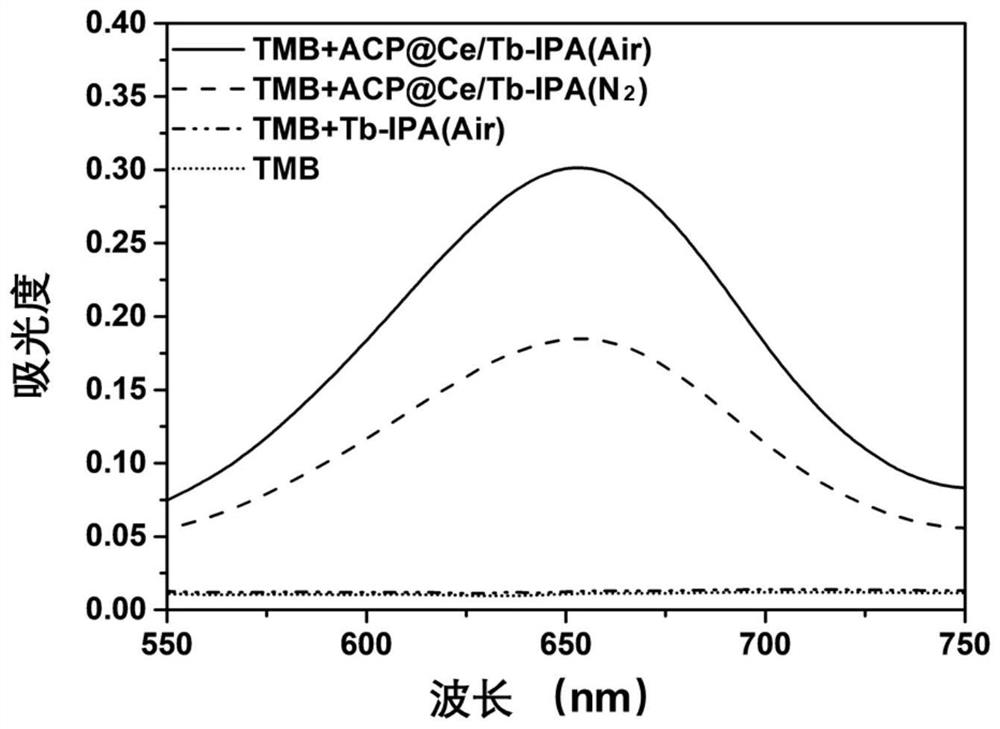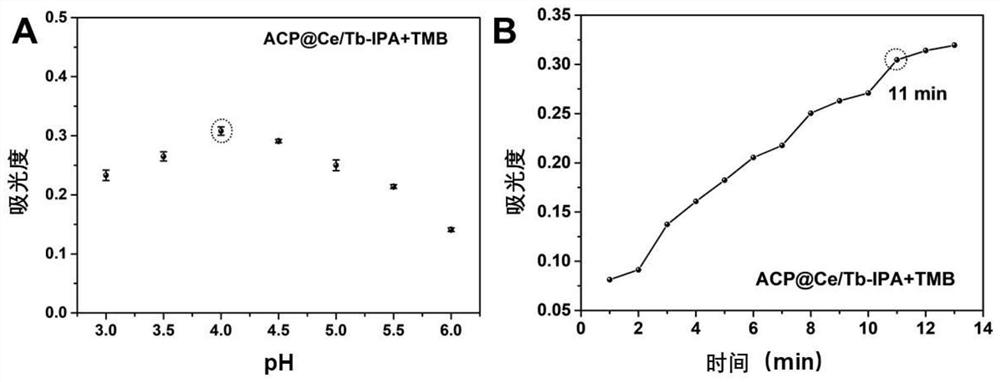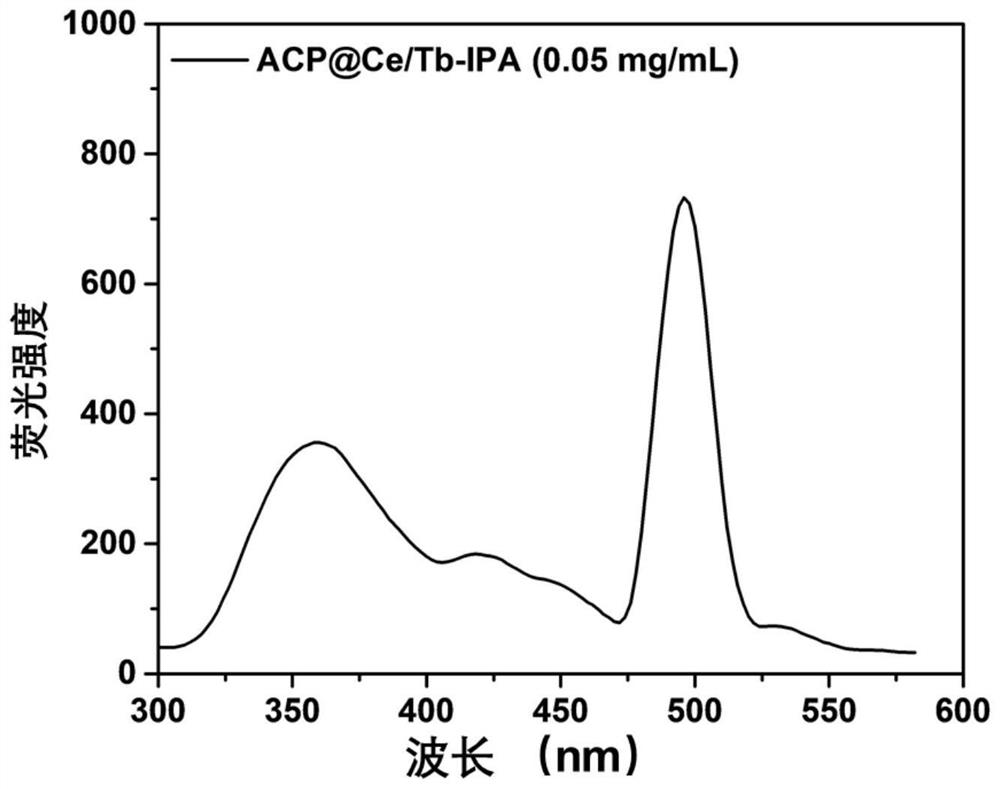Method for detecting pesticide residues based on ratio fluorescence and colorimetric dual modes of ACP (at) Ce/Tb-IPA
A technology of pesticide residues and ratiometric fluorescence, applied in the field of analytical chemistry, can solve the problems of single output signal, expensive detection equipment, complex operation of detection methods, etc.
- Summary
- Abstract
- Description
- Claims
- Application Information
AI Technical Summary
Problems solved by technology
Method used
Image
Examples
Embodiment 1
[0049] 1. the amount of substance is 0.50mmol of ceric ammonium nitrate (Ce(NH 4 ) 2 (NO 3 ) 6 ) and terbium nitrate hexahydrate (Tb(NO 3 ) 3 ·6H 2 O) be dissolved in 10mL deionized water and ultrasonically stirred to form a yellow homogeneous solution A;
[0050] 2. Pour solution A into 40mL N,N-dimethylformamide solution containing isophthalic acid (IPA, 100mM), and stir for 20min to form yellow homogeneous solution B;
[0051] 3. Pour solution B into the reaction kettle, heat and react in a blast oven at 150°C for 5 hours; after the product is naturally cooled, centrifuge at a speed of 10,000r / min for 10 minutes to separate the product, wash it with ethanol, and dry it in vacuum at 50°C for 12 hours;
[0052] 4. Take 100 mg of the dried reaction product, add 600 μL of ACP solution (20 mg / mL) and 1 mL of triethylamine to mix in 20 mL of deionized water, after ultrasonic treatment for 10 min, stir magnetically at low temperature for 12 h, centrifuge to collect the solid...
Embodiment 2
[0057] 1. Dissolve 10 mg of the prepared ACP@Ce / Tb-IPA in 10 mL of ultrapure water, and stir ultrasonically to form a yellow uniform solution;
[0058] 2. Take 920 μL of NaAc-HAc solutions with pH values of 3.0, 3.5, 4.0, 4.5, 5.0, 5.5, and 6.0, respectively, add 50 μL of 10 mM TMB and 50 μL of 1 mg / mL ACP@Ce / Tb-IPA to disperse Solution, mixed evenly, reacted at room temperature for 11 minutes, the color of the liquid changed from colorless to blue with time;
[0059] 3. Measure the absorbance with an ultraviolet-visible absorption spectrophotometer;
[0060] The result is as figure 2 As shown in A, as the pH increases, the absorbance value first increases and then decreases, and when the pH is controlled at 4.0, the absorbance (652nm) value is the highest and reaches a peak. It can be seen from the figure that when the pH is controlled at 4.0, the catalytic activity of the enzyme is the best;
[0061] 4. Take 920μL of NaAc-HAc solution (0.2M, pH 4.0), add 30μL of 10mM T...
Embodiment 3
[0063] 1. Dissolve 10 mg of the prepared ACP@Ce / Tb-IPA in 10 mL of ultrapure water, and stir ultrasonically to form a yellow uniform solution;
[0064] 2. Take 920μL NaAc-HAc solution (0.2M, pH 4.0), add 50μL 1mg / mL ACP@Ce / Tb-IPA dispersion solution to it in turn, mix well, measure the fluorescence spectrum of the above mixed solution with a fluorescence spectrophotometer .
[0065] Depend on image 3 It can be seen that there are two fluorescent signals at 358nm and 496nm.
PUM
| Property | Measurement | Unit |
|---|---|---|
| Particle size | aaaaa | aaaaa |
Abstract
Description
Claims
Application Information
 Login to View More
Login to View More - Generate Ideas
- Intellectual Property
- Life Sciences
- Materials
- Tech Scout
- Unparalleled Data Quality
- Higher Quality Content
- 60% Fewer Hallucinations
Browse by: Latest US Patents, China's latest patents, Technical Efficacy Thesaurus, Application Domain, Technology Topic, Popular Technical Reports.
© 2025 PatSnap. All rights reserved.Legal|Privacy policy|Modern Slavery Act Transparency Statement|Sitemap|About US| Contact US: help@patsnap.com



